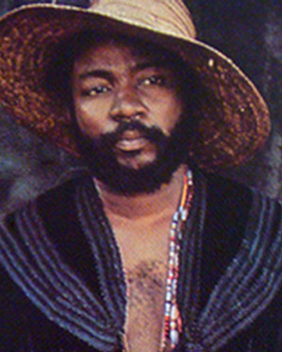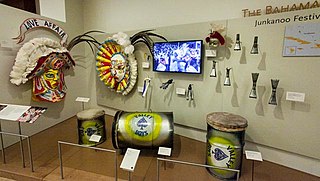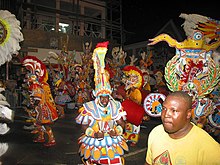The music of Trinidad and Tobago is best known for its calypso music, soca music, chutney music, and steelpan. Calypso's internationally noted performances in the 1950s from native artists such as Lord Melody, Lord Kitchener and Mighty Sparrow. The art form was most popularised at that time by Harry Belafonte. Along with folk songs and African- and Indian-based classical forms, cross-cultural interactions have produced other indigenous forms of music including soca, rapso, parang, chutney, and other derivative and fusion styles. There are also local communities which practice and experiment with international classical and pop music, often fusing them with local steelpan instruments.
The music of the Lesser Antilles encompasses the music of this chain of small islands making up the eastern and southern portion of the West Indies. Lesser Antillean music is part of the broader category of Caribbean music; much of the folk and popular music is also a part of the Afro-American musical complex, being a mixture of African, European and indigenous American elements. The Lesser Antilles' musical cultures are largely based on the music of African slaves brought by European traders and colonizers. The African musical elements are a hybrid of instruments and styles from numerous West African tribes, while the European slaveholders added their own musics into the mix, as did immigrants from India. In many ways, the Lesser Antilles can be musically divided based on which nation colonized them.

Junkanoo is a festival that was originated during the period of African chattel slavery in British American colonies. It is practiced most notably in The Bahamas, Jamaica and Belize, and historically in North Carolina and Miami, where there are significant settlements of West Indian people during the post-emancipation era. In the present day, there are considerable variations in performance and spelling, but there are the shared elements of masquerade, drumming, dance, and parading.
The music of the former Netherlands Antilles is a mixture of native, African and European elements, and is closely connected with trends from neighboring countries such as Venezuela and Colombia and islands such as Puerto Rico, Cuba, Santo Domingo, Haiti, Martinique, Trinidad, Dominica, and Guadeloupe. The former Netherlands Antilles islands of Curaçao and Aruba are known for their typical waltzes, danzas, mazurkas and a kind of music called tumba, which is named after the conga drums that accompany it.
The music of Bermuda is often treated as part of the Caribbean music area. Its musical output includes pop singer Heather Nova, and her brother Mishka. Collie Buddz has also gained international success with reggae hits in the US and the UK.
The music of Turks and Caicos Islands is best known for its ripsaw music. It is accompanied by an array of instruments, including maracas, triangles, box guitar, conga drums, goat and cowskin drums, accordion, concertina and, most prominently and uniquely, the carpenter saw.
The music of Saint Vincent and the Grenadines includes thriving music scenes based on Big Drum, calypso, soca, steelpan and also reggae. String band music, quadrille, bélé music and traditional storytelling are also popular.

The music of Saint Kitts and Nevis is known for a number of musical celebrations including Carnival. The last week in June features the St Kitts Music Festival, while the week-long Culturama on Nevis lasts from the end of July into early August.

The music of Antigua and Barbuda is largely African in character, and has only felt a limited influence from European styles due to the population of Antigua and Barbuda descending mostly from West Africans who were made slaves by Europeans.
Rake-and-scrape is the traditional music of The Bahamas, alongside Junkanoo. It combines African musical elements with European musical elements to create a sound comparable to other Caribbean music while remaining distinct.
Bahamian culture is a hybrid of African, European, and other cultures.
Avvy is a songwriter and performer contributing to the art of Bahamian folk music, Junkanoo and Rake-and-scrape. In 2014 his singles "Dirty Nagua Rake" and "Swing Swing" took top position in the local Bahamian charts.
Blake Alphonso Higgs (1915–1986), better known as "Blind Blake", was the best-known performer of goombay and calypso in the Bahamas from the 1930s to the 1960s.

Macfarlane Gregory Anthony Mackey, known professionally as Tony McKay and Exuma, was a Bahamian musician, artist, playwright, and author best known for his music that blends folk, rock, carnival, junkanoo, calypso, reggae, and African music stylings.

Goombay is a form of Bahamian music and a drum used to create it. The drum is a membranophone made with goat skin and played with the hands. The term Goombay has also symbolized an event in the Bahamas, for a summer festival with short parades known as ‘Junkanoo’.
Bahamian cuisine refers to the foods and beverages of The Bahamas. It includes seafood such as fish, shellfish, lobster, crab, and conch, as well as tropical fruits, rice, peas, pigeon peas, and pork. Popular seasonings commonly used in dishes include chilies, lime, tomatoes, onions, garlic, allspice, ginger, cinnamon, rum, and coconut. Rum-based beverages are popular on the islands. Since the Bahamas consist of a multitude of islands, notable culinary variations exist.
Meta Davis Cumberbatch MBE was a Trinidad-born pianist, composer, poet, playwright and cultural activist, who spent the majority of her life in The Bahamas, where she used her talents to enhance the country's cultural development, becoming known as the "Mother of the Arts". At the 2014 Independence anniversary celebrations in Nassau she was honoured as a Bahamian "Cultural Warrior".

ZNBN-FM is a radio station in Nassau, Bahamas broadcasting a Caribbean Music, Bahamian Junkanoo and rake-and-scrape radio format.








